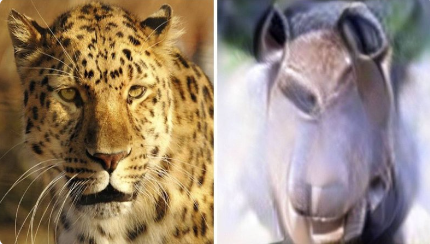Unraveling the mysteries of the human mind, Japanese researchers have developed a “brain decoding” technology, leveraging artificial intelligence (AI) to translate human brain activity into mental images of objects and landscapes.
Led by a team from the National Institutes for Quantum Science and Technology (QST) and Osaka University, this approach produced vivid depictions such as a distinct leopard with discernible features like ears, mouth, and spots and objects like an airplane with red-wing lights.
Replicating mental imagery
Past research has managed to recreate images people have seen by analyzing their brain activity. However, making these mental images visible to others is still difficult.
Only a few studies have successfully shown mental images, and these images were usually limited to certain categories like human faces, letters, or shapes.
“Therefore, visualizing mental imagery for arbitrary natural images stands as a significant milestone,” said the researchers in the study.
The researchers exposed participants to about 1,200 images and then meticulously analyzed and quantified the correlation between their brain signals and the visual stimuli using functional magnetic resonance imaging (fMRI).
This mapping was then used to train a generative AI to decipher and replicate the mental imagery derived from brain activity.
“The experimental results demonstrated the capabilities of our proposed framework in reconstructing both natural images and artificial shapes that were imagined by human participants,” said the study.
The implications of this “brain decoding” could help in potential applications in medicine and welfare, said the researchers in the study.
Convergence of neuroscience and AI
Now that we have the technology to see mental images based on brain activity, it could help create new communication devices. Additionally, it allows scientists to explore and understand how hallucinations and dreams work in the brain.
QST researcher and author of the study Kei Majima said that even though we’ve used tools like microscopes to see tiny things, looking into the depths of the human mind is a completely new and unexplored frontier. It’s like discovering a whole new world within ourselves.
The study was published in the scientific journal Neural Networks.
Study abstract:
Visual images observed by humans can be reconstructed from their brain activity. However, the visualization (externalization) of mental imagery is challenging. Only a few studies have reported successful visualization of mental imagery, and their visualizable images have been limited to specific domains such as human faces or alphabetical letters. Therefore, visualizing mental imagery for arbitrary natural images stands as a significant milestone. In this study, we achieved this by enhancing a previous method. Specifically, we demonstrated that the visual image reconstruction method proposed in the seminal study by Shen et al. (2019) heavily relied on low-level visual information decoded from the brain and could not efficiently utilize the semantic information that would be recruited during mental imagery. To address this limitation, we extended the previous method to a Bayesian estimation framework and introduced the assistance of semantic information into it. Our proposed framework successfully reconstructed both seen images (i.e., those observed by the human eye) and imagined images from brain activity. Quantitative evaluation showed that our framework could identify seen and imagined images highly accurately compared to the chance accuracy (seen: 90.7%, imagery: 75.6%, chance accuracy: 50.0%). In contrast, the previous method could only identify seen images (seen: 64.3%, imagery: 50.4%). These results suggest that our framework would provide a unique tool for directly investigating the subjective contents of the brain such as illusions, hallucinations, and dreams.
Bitchute: https://www.bitchute.com/channel/YBM3rvf5ydDM/
Telegram: https://t.me/Hopegirl587
EMF Protection Products: www.ftwproject.com
QEG Clean Energy Academy: www.cleanenergyacademy.com
Forbidden Tech Book: www.forbiddentech.website













